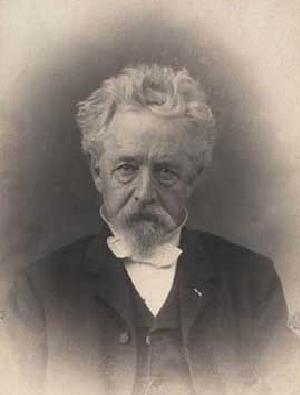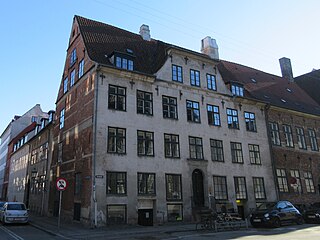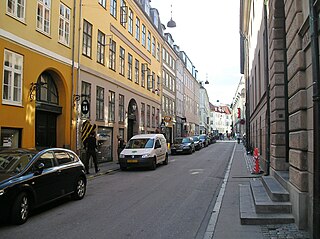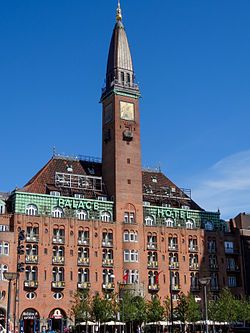
Nørrebrogade is the principal shopping street of the Nørrebro district of Copenhagen, Denmark. It runs from The Lakes in the southeast to Nørrebro station in the northwest, linking Frederiksborggade and Queen Louise's Bridge with Frederikssundsvej. The street passes Assistens Cemetery, Nørrebro Runddel and the Superkilen linear park. Buildings include the multipurpose venue Nørrebrohallen and two churches.

North Zealand, also North Sealand, refers to the northern part of the Danish island of Zealand which is not clearly defined but generally covers the area north of Copenhagen. The Danish tourist authorities have recently introduced the term Danish Riviera to cover the area in view of its increasing importance for tourism. The area has three royal castles and offers resorts with beaches, as well as lakes and forests. In addition to Kronborg Castle, three of the North Zealand forest areas used for royal par force hunting are included in the UNESCO World Heritage List.
Volmars Drosted, was a Danish architect, born in Frederiksberg. He worked on a number of public buildings for the city of Helsingør as well as the thorough restoration of the famous Marienlyst Castle in 1953.

Marienlyst Castle is a palatial residence located in Helsingør, Denmark. It was named after King Frederik V of Denmark's second wife, Juliana Maria, the queen consort of Denmark and Norway. The building formerly served as a royal pavilion of Kronborg Castle and was mostly used as a venue for pleasure and hunting. It was also used by the director-general of the Øresund Custom House, Colonel Adam Gottlob von Krogh and his wife Magdalene, between 1796 and 1847.

Vesterbrogade is the main shopping street of the Vesterbro district of Copenhagen, Denmark. The 1.5 km long street runs from the City Hall Square in the east to Pile Allé in Frederiksberg in the west where it turns into Roskildevej. On its way, it passes Copenhagen Central Station as well as the small triangular square Vesterbros Torv. It is one of four such -bro streets, the other being Nørrebrogade, Østerbrogade and Amagerbrogade.

Vester Voldgade is a street in Copenhagen, Denmark which runs from Jarmers Plads to the waterfront between Frederiksholms Kanal and Langebro, passing the City Hall Square on the way.
Events from the year 1859 in Denmark.

Vilhelm Klein was a Danish architect who adopted the Historicist approach, frequently emulating the so-called Rosenborg style and the Italian Renaissance style.

The Grand Theatre, located in Mikkel Bryggers Gade, a small side street off Strøget, is one of the oldest cinemas in Copenhagen, Denmark. The cinema is based in the rear side of the Palace Hotel complex on City Hall Square. The building was completed to an Art Deco design by Anton Rosen in 1910. It was listed in the Danish Registry of Protected Buildings and Places in 1993.

Savoy Hotel Copenhagen is a 66-room, privately run hotel located at Vesterbrogade 34 in the Vesterbro district of Copenhagen, Denmark. The hotel is based in the rear wing of the Løvenborg Building, Denmark's first example of Art Nouveau.

Åboulevard is a street in central Copenhagen, Denmark. Together with H. C. Andersens Boulevard in the city centre and Borups Allé, it forms a major artery in and out of the city. The road is built over Ladegårds Å, a canal originally built to supply Copenhagen with water, which still runs in a pipe under it, feeding water into Peblinge Lake.

Vestergade is a street in central Copenhagen, Denmark, linking Gammeltorv in the northeast with the City Hall Square in the southwest. The street defines the southern boundary of Copenhagen's Latin Quarter. Most of the buildings in the street date from the years after the Copenhagen Fire of 1795.

Helsingør City Museum is a local history museum in Helsingørm Denmark. The 16th-century building in which it is based is known as the Cammelite House although the Carmelite brothers from the adjacent Priory of Our Lady have in fact only built a minor part of the build.

Frederiksborggade is a street in central Copenhagen, Denmark. It runs from Kultorvet square in the southeast to Søtorvet where Queen Louise's Bridge connects it to Nørrebrogade in Nørrebro on the other side of The Lakes. The street is effectively divided in two by Nørreport station on Nørre Voldgade. The short, southern portion, together with Kultorvet and Købmagergade, forms a pedestrian zone between the station and Strøget at Amagertorv. The wider and younger northern portion is open to car traffic.

The Mikkel Vibe House is a historic property located at Strandgade 32 in the Christianshavn neighbourhood of Copenhagen, Denmark. It is believed to be the oldest building in Christianshavn and takes its name after Mikkel Vibe who was mayor of Copenhagen.

Hotel Marienlyst is a seaside hotel located just north of Kronborg Castle in Helsingør, Denmark. It takes its name after Marienlyst House, a neighboring former royal summer retreat, which was part of it from its foundation in 1859 until 1896. Facilities include a restaurant, bar, wellness area and a casino. The Denmark national team stays at the hotel in connection with home matches and training sessions.

Kattesundet is a side street to the shopping street Strøget in the Old Town of Copenhagen, Denmark. It runs from Vestergade in the northwest to Lavendelstræde-Slutterigade in the southeast, linking Larsbjørnsstræde with Hestemøllestræde. The buildings that line the southwest side of the street all date from the years after the Copenhagen Fire of 1795. Six of them, No. 2 and No. 10-18, are listed in the Danish registry of protected buildings and places. The other side of the street is dominated by the rear side of Copenhagen Court House and the Anton Rosen Jugendstil Metropol Building from 1908.
Frantz Philip Nicolai Lange was a Danish architect and master mason. He made a significant contribution to the rebuilding of Copenhagen in the years after the Copenhagen Fire of 1795. Most of his buildings have been listed on the Danish registry of protected buildings and places.

Rytterhuset, located at Nordre Strandvej 230, Ålsgårde, Helsingør Municipality, Denmarkm was built in 1889 to a national romantic design by Martin Nyrop as summer residence for the painter Frants Henningsen. The property, including a detached atelier, a jetty with a bathhouse and a number of other outbuildings, were listed in the Danish registry of protected buildings and places in 1993. The ample use of wood ornamentation and polychromy are both tell-tale features of this particular architectural style. The name of the building was inspired by a relief of a horseman located above the main entrance.

Mikkel Bryggers Gade is a pedestrianized street in the Old Town of Copenhagen, Denmark. It runs from Frederiksberggade in the north to Lavendelstræde in the south. The art cinema Grand Teatret is located in the street. It is based in the large Palace Hotel complex.























